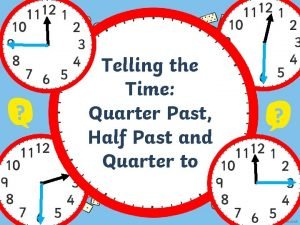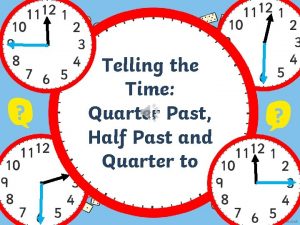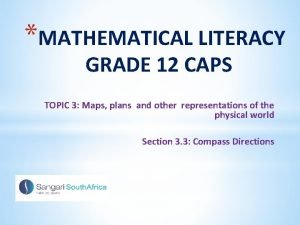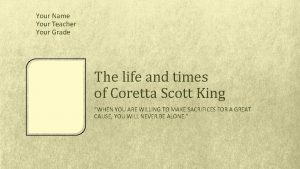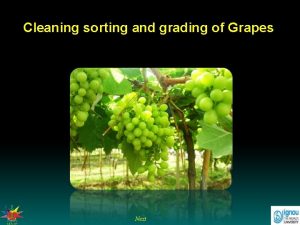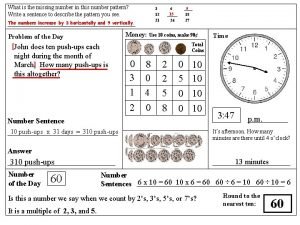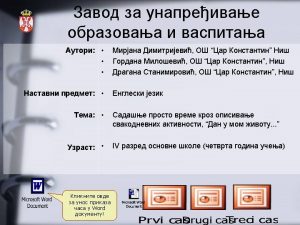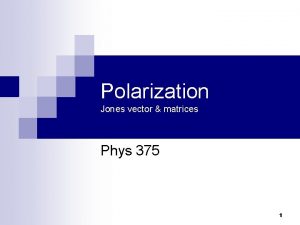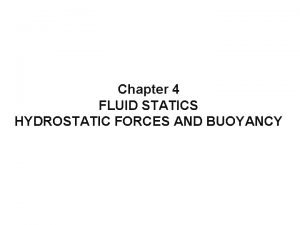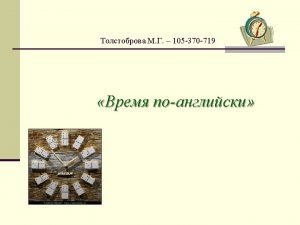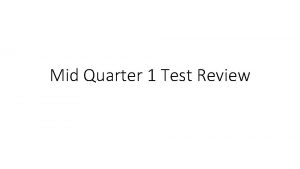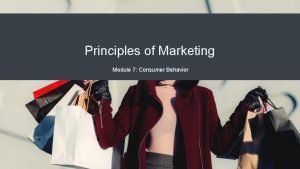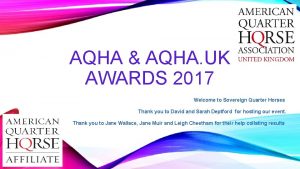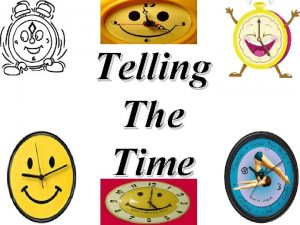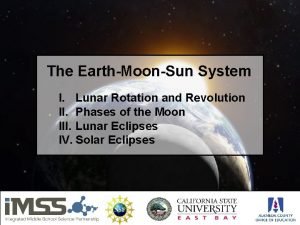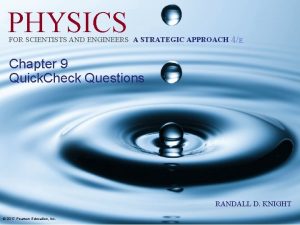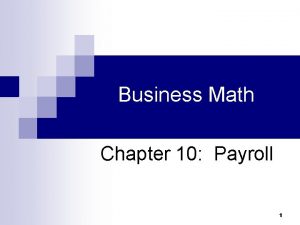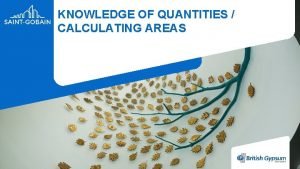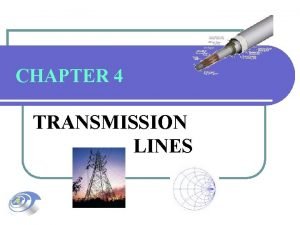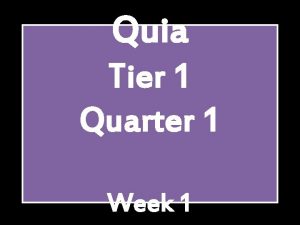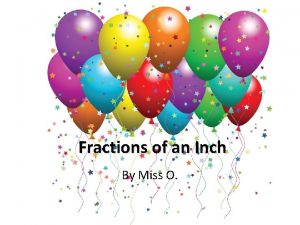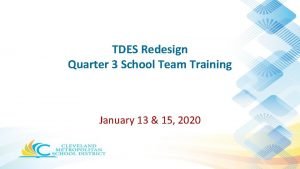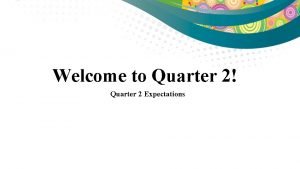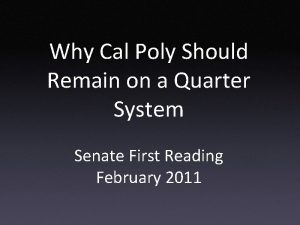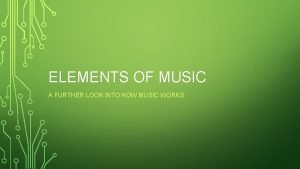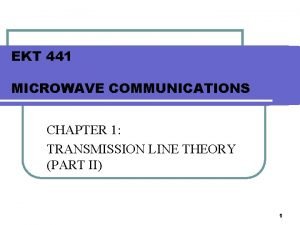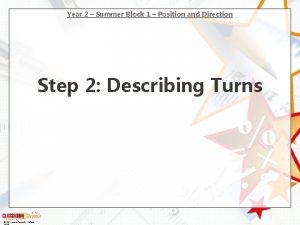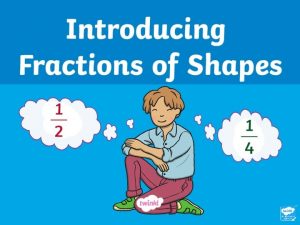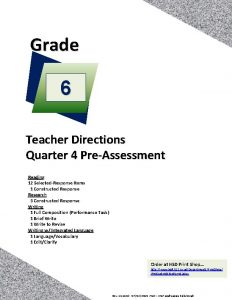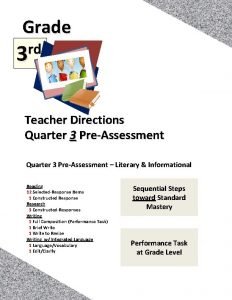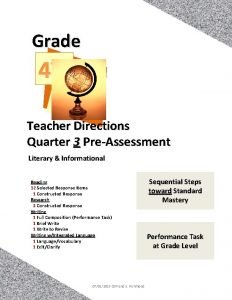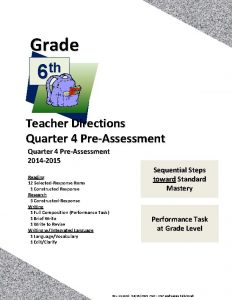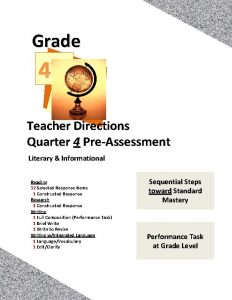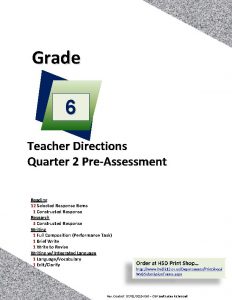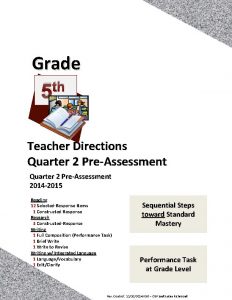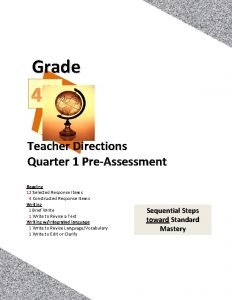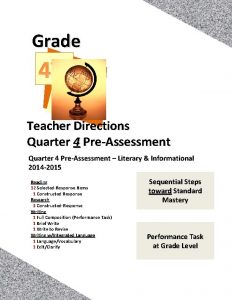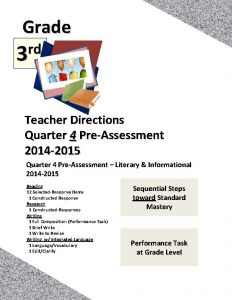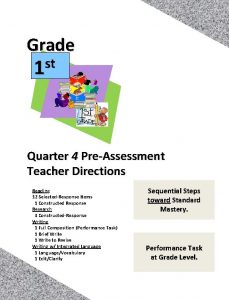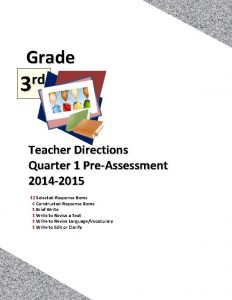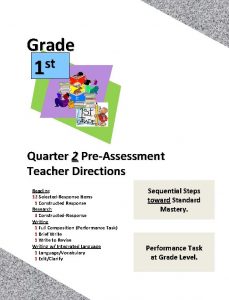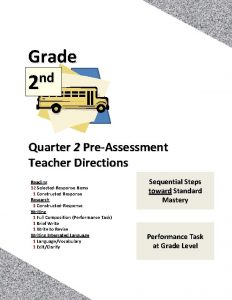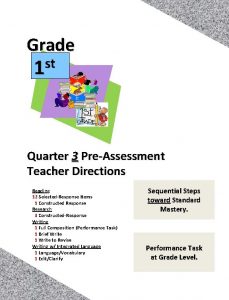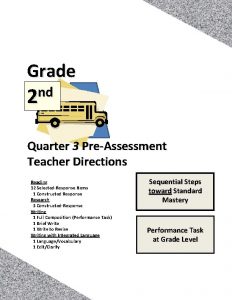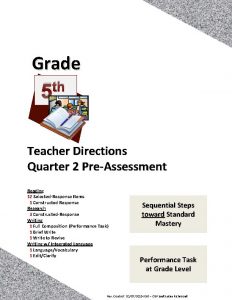Grade K K Quarter 3 PreAssessment Teacher Directions







































- Slides: 39

Grade K K Quarter 3 Pre-Assessment Teacher Directions Reading 12 Selected-Response Items Research 2 Constructed-Response Writing 1 Brief Write 1 Write to Revise 1 Full Composition (Optional Performance Task) Writing w/ Integrated Language as Part of the Performance Task Language/Vocabulary Edit/Clarify Sequential Steps toward Standard Mastery Performance Task at Grade Level

Grade K Quarter Three Pre -Assessment Reading: Literature Targets Standards DOK 3 Word Meanings RL. 4 1 -2 6 Text Structures/Features RL. 7 2 5 Analysis Within and Across Texts RL. 9 4 Reading: Informational Targets Standards DOK 10 Word Meanings RI. 4 1 -2 11 Reasoning and Evidence RI. 8 3 -4 12 Analysis Within and Across Texts RI. 9 2 -3 -4 Note: There may be more than one standard per target. Standards can have different DOKs per target. Actual writing standards assessed are boxed. Narrative Writing and Language Targets Standards DOK 1 a Brief Narrative Write W. 3 a, W. 3 b, W. 3 c, W. 3 d 3 1 b Write-Revise Narrative W. 3 a, W. 3 b, W. 3 c, W. 3 d 2 2 Full Narrative Composition W-3 a, W-3 b, W-3 c, W-3 d, W-5, W -8 4 8 Language-Vocabulary Use L. K. 1 f (Integrated w Performance Task) 1 -2 9 Edit and Clarify L. K. 1 c (Integrated w Performance Task) 1 -2

All elementary ELA assessments were reviewed and revised in June of 2015 by the following amazing and dedicated HSD K-6 th grade teachers. Deborah Alvarado Lincoln Street Ko Kagawa Minter Bridge Linda Benson West Union Jamie Lentz Mooberry Anne Berg Eastwood Sandra Maines Quatama Aliceson Brandt Eastwood Gina Mc. Lain TOSA Sharon Carlson Minter Bridge Teresa Portinga Patterson Deborah Deplanche Patterson Judy Ramer Consultant Alicia Glasscock Imlay Sara Retzlaff Mc. Kinney Sonja Grabel Patterson Jami Rider Free Orchard Megan Harding Orenco Kelly Rooke Free Orchard Renae Iversen TOSA Angela Walsh Witch Hazel Ginger Jay Witch Hazel Rev. Control: 07/02/2015 HSD – OSP and Susan Richmond 3

Note: During kindergarten students are normally not reading. Read the stories to the students and ask the questions as Listening Comprehension questions. Most students should be able to point to pictures and answer questions with support and prompting. Please DO tell students what the pictures show if students aren’t clear about the image. Recommendation: The literary section can be assessed at a different time than the informational section. The informational section includes two passages as required by standard RI. K. 9 and may require more time. Listening comprehension prepares students for the kind of questions that are higher-level questions (rather than decodable text which is not conducive to higher-level questioning). Kindergarten Directions: Teachers will need: 1. Teacher Directions Section 2. Literature and Informational texts. Read each to your class 2 -3 times. Discuss the story so that students are clear about language and vocabulary terms. Some teachers choose to project these onto an overhead screen. For Assessing Students Individually (if you assess in small groups you may want to make more than one copy of the following): 3. A copy of the Literature and Informational Stories 4. A copy of the Picture Prompts Students will need: 1. The Student Assessment Copy This includes: a. Student Record Form (for teacher to mark) b. Constructed Response Answer Sheets c. Student Check-List (optional use) Performance Task Optional (after the assessment: The performance task is at grade level and can be used as Narrative pre-test for writing at the beginning of this quarter. The end quarter CFA can be used as a post-test. Performance Task Possible Pre-Classroom Activity • Review vocabulary or language students may struggle with connected to the topic. • A short video about a baby snapping turtle’s first time in water: https: //www. youtube. com/watch? v=8 id. Jz. Et. XQrk • A short video about a snapping turtle found in a backyard: https: //www. youtube. com/watch? v=hnl. T 8 ipd. CFk Performance Task: This should be done with much support and prompting as needed. Some students will be able to do more independently. Write a story about a snapping turtle. Describe what happened to the snapping turtle at the beginning, middle and ending of your story. Rev. Control: 07/02/2015 HSD – OSP and Susan Richmond 4

Pre-Assessment and Learning Progressions The pre-assessments are unique. They measure progress toward a standard. Unlike the Common Formative Assessments which measure standard mastery, the pre-assessments are more like a base-line picture of a student’s strengths and gaps, measuring skills and concepts students need “along the way, ” in order to achieve standard mastery. Beg. of QTR Example of a Learning Progression for RL. 2. 1 Pre-Assessments Measure Adjustment Points (in purple) After the pre-assessment is given, Learning Progressions provide informal formative assessment below and near grade-level “tasks” throughout each quarter. DOK 1 - Ka Recall who, what, where, when, why and how about a story read and discussed in class. CFA DOK - Kc Use and define Standard Academic Language: who, what, where, when, why, and how; ask, answer, questions, key details DOK 1 - Cd Connect the terms who to characters; where and when to setting; what and how to sequence of events. DOK 1 - Cf Ask and answer who, what, where, when, why and how questions about key details in a text. DOK 2 - Ch Concept Development Student understands that key details help tell who, what, where, when, why and how. DOK 2 - Ck Uses key details to identify who, what, where, when, why and how about a story not read in class. RL. 2. 1 grade -level standard assessment. Throughout the QTR DOK 2 -Cl Finds information using key details to answer specific questions about a new story. END of QTR Standard Mastery RL. 2. 1 Ask and answer such questions as who, what, where, when, why, and how to demonstrate understanding of key details in a text So what about a “post-assessment? ” There is not a standardized post-assessment. The true measure of how students are doing “along the way, ” is assessed in the classroom during instruction and classroom formative assessment. For this reason The CFA’s are not called “post-assessments. ” The CFAs measure the “end goal, ” or standard mastery. However, without the pre-assessments, how will we know what our instruction should focus on throughout each quarter? Learning Progressions: are the predicted set of skills needed to be able to complete the required task demand of each standard. The learning progressions were aligned to Hess’ Cognitive Rigor Matrix. The pre-assessments measure student proficiency indicated on the boxes in purple (adjustment points). These points are tasks that allow us to adjust instruction based on performance. For instance, if a student has difficulty on the first “purple” adjustment point (DOK-1, Cf) the teacher will need to go back to the tasks prior to DOK-1 Cf and scaffold instruction to close the gap, continually moving forward to the end of the learning progression. There is a Reading Learning Progression checklist for each standard in each grade that can be used to monitor progress. It is available at: http: //sresource. homestead. com/Grade-2. html Rev. Control: 07/02/2015 HSD – OSP and Susan Richmond 5

Quarter Three Reading Literature Learning Progressions. The indicated boxes highlighted before the standard, are assessed on this preassessment. The standard itself is assessed on the Common Formative Assessment (CFA) at the end of each quarter. DOK 1 - Ka Recalls word meanings from a text read and discussed in class. DOK 1 - Kc Understands and uses correctly Standard Academic Language: ask, answer, questions, unknown, words and text. DOK 1 - Ce Select appropriate words when meaning is evident (point to the picture that means ___ or shows a ___). DOK 2 - Ch Concept Development: Student understands that words represent things, actions and feelings. (L. K. 4 a Identify new (L. K. 5 c Identify realmeanings for life connections familiar words and SELECTED RESPONSE between words and apply them their use. . ) accurately. . ) DOK 1 - Ka DOK 1 - Kc Locate illustrations Define and be able to in a story. use Standard Academic Language: Recall specific describe, relationship, points in the story. between, appear illustration, story, Read and discussed. moment, part of a story and depict. DOK 1 - Ka Locate specific characters in a story. DOK 1 - Cf Asks and answers basic who, what, when, where and how questions about unknown words in a text read and discussed in class. DOK – 1 Cf Answer questions that require students describing specific parts of the story that have illustrations (Point and show). DOK – 2 Ch Student understands that illustrations tell about specific parts of a story. DOK – 2 Cl Locates words that give specific meaning to a text (what words help us to know how ___ feels) read and discussed in class. L. K. 4 (Determine or clarify the meaning of unknown and multiple-meaning words and phrases. ) DOK 2 - Ch Explain what is happening in the story by doing a picture walk. Specify which illustrations show details about specific moments in a story. SELECTED RESPONSE DOK – 2 APn Asks questions about words within the context of the story (What is a ___? ) Standard RL. K. 4 Ask and answer questions about unknown words in a text. Answers questions about words within the context of a story (Why did the boy say__ when__)? SELECTED RESPONSE DOK 2 – Cl Standard RL. K. 7 With prompting and support, describe the relationship between illustrations and the story in which they appear (e. g. , what moment in a story an illustration depicts). DOK 4 – SYV Standard Understand Answers basic Concept Can Refers to the Lists Explains or Analyzes the RL. K. 9 With prompting be able to use questions (no Development: sequence correct part adventures shows how adventure or and support, compare Standard inference) Understands the events of of a text or one experiences and contrast the Academic about what an an when asked experiences characters between two adventures and Language: characters and adventure is. adventure or about a of characters adventures or characters with a experiences of characters, story, their experience specific event in two experiences prompt(s), (i. e. , characters in familiar compare, experiences or Understands (beginning, within a separate are the same which character stories. contrast, same, adventures. what an middle and sequence of lists or or different showed/had___ different, experience is. ending) in a an adventure columns. than another during his/her adventures few or experience. (prompt with adventure? ) familiar and sentences descriptive experiences. (orally). SELECTED adjectives). RESPONSE CONSTRUCTED Not assessed SELECTED RESPONSE DOK 1 - Kc DOK 1 - Cf DOK 2 - Ch DOK 2 - Ci DOK 2 - Cl DOK 3 - ANp DOK 3 - Cu DOK 3 - ANz Rev. Control: 07/02/2015 HSD – OSP and Susan Richmond 6

Quarter Three Reading Informational Learning Progressions. The indicated boxes highlighted before the standard, are assessed on this preassessment. The standard itself is assessed on the Common Formative Assessment (CFA) at the end of each quarter. DOK 1 - Ka Recalls word meanings from an informational text read and discussed in class. DOK 1 - Ka Locate or tell about specific points in a text read and discussed in class. DOK 1 - Kc Understands and uses correctly Standard Academic Language: ask, answer, questions, unknown, words and text – when listening to and discussing informational texts. DOK 1 - Kc Understand use Standard Academic Language: author, points, reasons, identify, support and text. DOK 1 - Ce Select appropriate words when meaning is evident (point to the picture that means ___ or shows a ___). (L. K. 4 a Identify new meanings for familiar words and apply them accurately. . . ) DOK 1 - Cf Answer questions when asked about specific points in a text using who, what, when, where or how. DOK 1 - Cf Asks and answers basic who, what, when, where and how questions about unknown words in an informational text read and discussed in class. DOK – 2 Ch Concept Development: Student understands that words represent things, actions and feelings. DOK 2 - Cj Can match points to reasons – causes to effects (matches a picture of lava to a volcano, or a danger sign to a fire) from a text read and discussed in class. DOK 2 - Cl Locate reasons in the text that support the specific points by explaining why (snakes are harmful …if they are poisonous tells why the author says don’t touch!”) DOK 1 - Kc Understand use Standard Academic Language: similarities and differences, texts, illustrations, descriptions, procedures and topic. DOK 1 - Cf Answer what, who, when and where questions about illustrations, descriptions, and procedures in a read/discussed text. Not assessed DOK 2 - Ch Concept Development: Student understands that two texts about the same topic can have similar or different illustrations, descriptions and procedures. DOK 2 - Ck Make generalizations between two texts on the same topic (how they are generally the same/different) about specific illustrations, descriptions or procedures. SELECTED RESPONSE DOK – 2 ANs Distinguish relevant and irrelevant reasons of support about specific points in a text (explains why ___ is a good reason (relevant) to not ___. DOK 3 - Cv Identify reasons an author gives to support points in a text with little prompting can draw or identify in a new text read but not discussed in class. SELECTED RESPONSE DOK 1 - Ka Recall details about specific illustrations, descriptions or procedures from a text read and discussed in class. DOK – 2 APn Asks questions about words within the context of the story (What is a ___? ) Answers questions about words within L. K. 4 (Determine or the context of a story (L. K. 5 c Identify real- clarify the meaning of (Why did the boy life connections unknown and multiple say__ when__)? between words and -meaning words and their use. . ) phrases. ) SELECTED RESPONSE DOK 2 - Ch Concept Development: Understands that a “point” is what an author is trying to explain and “reasons” tell why. DOK – 2 Cl Locates words that give specific meaning to a text (what words help us to know how ___ feels) read and discussed in class. DOK 3 - ANP Gather, analyze, and organize illustrations, descriptions or procedures from two texts on the same topic (able to organize by lists or columns). DOK 3 - APx Understands the concept of identifying similarities and differences between two texts (can explain or show without much prompting). SELECTED RESPONSE DOK 3 - EVC Cite evidence that supports points in a text (can answer a question by referring to a specific place in the text). Standard RI. K. 4 Ask and answer questions about unknown words in a text. Standard RI. K. 8 With prompting and support, identify the reasons an author gives to support points in a text. Not assessed DOK 2 - SYG Gather (to Synthesize) information within one source – finds all of the attributes about a topic that support___ (requires knowing similarities and differences). DOK 4 - SYU Gather (to Synthesize) information within two sources – finds all of the attributes about a topic from both sources that support ___. CONSTRUCTED RESPONSE Rev. Control: 07/02/2015 HSD – OSP and Susan Richmond Standard RI. K. 9 With prompting and support, identify basic similarities in and differences between two texts on the same topic (e. g. , in illustrations, descriptions, or procedures 7

A Note about constructed responses: Constructed response answers are not written “in stone. ” There is no perfect way a student should respond. Look for the general intent of the prompt and student response and follow the rubric below as much as possible. Use your best judgment. Unlike DOK-1 questions where there is one right and wrong answer, constructed responses are more difficult to assess. Overall consistency of intent based on most of your student responses can guide you. Quarter 3 Pre-Assessment Constructed Response Answer Key Literary Passage: Rocky Runs Away 7. RL. K. 9 Prompt: Write and/or draw two things that Rocky did when the campers came. Write and/or draw two things that mother did when the campers came. Constructed Response Research Rubrics Target 2 Locate, Select, Interpret and Integrate Information. The response gives sufficient evidence of the ability to locate and select information that shows or tells two things that Rocky did in the story and two things that mother did in the story. Students could write or draw (and/or tell) that Rocky (1) heard a noise, (2) saw a camper and (3) ran away. Students could write or draw (and/or tell) that mother (1) warned her babies about campers, (2) snapped at the camper and (3) grabbed the camper. The response gives sufficient evidence of the ability to interpret and integrate information to draw or write about what both Rocky and mother did when the campers came. Students may integrate other information from the story if it is actually in the text. Constructed Response Research Rubrics Target 2 Locate, Interpret and Integrate Information. Student Select, draws or writes about what both characters did when the campers came: 2 • Illustrates /names both Rocky and mother • Writes or draws what both were doing when the camper(s) came • Writes or draws two or more things that both characters were doing when the camper(s) came. 1 Student draws or writes about what both characters did when the campers came: • Illustrates /names both Rocky and mother • Writes or draws about Rocky or mother, but not both, or not both in full detail • Writes or draws one thing that one or both characters were doing when the camper(s) came. 0 Student drawing or writing may have 1 detail about one of the characters but does not strongly connect with the prompt to show the relationship with the camper(s) arrival. Toward RL. K. 9 DOK 3 - ANz Analyzes the adventure or experiences between two characters with a prompt(s), (i. e. , which character showed/had___ during his/her adventure? ) Rev. Control: 07/02/2015 HSD – OSP and Susan Richmond 8

Constructed Response Answer Key Literary Passages: From the Beach to the Sea and From the Sand to the Pond 14. Write and draw about sea turtles and snapping turtles. Write and draw to show snapping turtles move. 1 3 2 Write and draw to show sea turtles move. Student writes and draws about a turtle with legs to show a snapping turtle moves. Student writes and draws about a turtle with flippers to show a sea turtle moves (or drags) across the sand. ________________ ________________ Write and draw details about the turtle that lives in the sea. 4 Write and draw details about the turtle that lives in a pond. Student writes and draws 2 or more details about a snapping turtle that are different than a sea turtle ( i. e. , legs, sharp claws, snapping jaw, long tail, swims in pond). Student writes and draws 2 or more details about a sea turtle (i. e. , flippers, swimming in the sea, growing large) that are different than the snapping turtle. ________________ ________________ Student Response Examples Constructed Response Research Rubrics Target 2 Locate, Select, Interpret and Integrate Information. Toward RI. K. 9 DOK 4 - SYU Gather (to Synthesize) information within two sources – finds all of the attributes about a topic from both sources that support ___. 2 #1 - Turtle has legs #2 - Turtle has flippers #3 - 2 or more details about a sea turtle #4 - 2 or more details about a snapping turtle 1 #1 or #2 - only one is correct #3 - 1 detail about a sea turtle #4 - 1 detail about a snapping turtle 0 None or very few of the pictures show an understanding of the prompts Rev. Control: 07/02/2015 HSD – OSP and Susan Richmond 9

Quarter 3 Pre-Assessment Brief Write & Write to Revise Answer Keys Informational Passage: From the Beach to the Sea Questions #15 and #16 address language standards that are assessed on SBAC as part of Claim #2 – Writing. These two questions are not on the student Listening Comprehension answer key and recording sheet, but may be used for instructional guidance in language and writing as desired. 15. Write letters, words or pictures to tell what will happen next. Write a Brief Text, W. 3 d Temporal Words Target 1 a First Next Then The response follows a logical order using the temporal words First, Next and Then… 2 Student writes or draws something about the turtle leaving the egg or searching for water for Next. Students writes or draws something that could happen after the turtle leaves for Then that makes logical sense – such as walking on the sand to the sea. The response partially follows a logical order using the temporal words First, Next and Then… 1 Student writes or draws something about the turtle leaving the egg or searching for water for Next and/or something that could happen after the turtle leaves for Then, Then that makes logical sense, but does not do both. 0 The response does not logically follow a logical order using the temporal word First, Next and Then… Student does not write or draw in a logical way about what happened next or then. 16. Use words and/or pictures to show where a sea turtle can go. Revise a Text, W. 3 b sensory elaboration in details, Writing Target 1 b Student should elaborate on details from the passage to show where a sea turtle can go. This should include the sand or the sea (at least one). 2 Includes sand or sea in picture/words + other details from a passage 1 Includes sand or sea in picture/words (one) and no other details. 0 Does not include sand or sea or any details from passage. Rev. Control: 07/02/2015 HSD – OSP and Susan Richmond 10

Performance Task Answer Key W. K. 3: Use a combination of drawing, dictating, and writing to narrate a single event or several loosely linked events, tell about the events in the order in which they occurred, and provide a reaction to what happened. Questions #17 (Performance Task) is optional. If scoring, language standards L. K. 1 f (expanded sentences; language and vocabulary ) and L. K. 1 c (plural pronouns, edit and clarify) as listed on the cover sheet of this assessment, are integrated in the scoring key below. In grades 1 – 6 language and vocabulary, and edit and clarify are assessed separately. 17. Task: Write a story about a snapping turtle. Describe what happened to the snapping turtle at the beginning, middle and end of your story. The character in my story. What happened at the beginning. What happened in the middle. What happened at the end. Students receive three scores, one for each criterion. In kindergarten, use your judgment along with the writing rubric to decide how the final product best supports each of these three areas. Purpose and Organization (4) • • • Introduces a character in some way Stays on topic about the character Has a beginning, middle and ending that is logical. 1 2 3 4 Language -Elaboration of Evidence (4) Conventions (4) • • Uses relevant details or examples of a snapping turtle Uses vocabulary learned from the passage Uses complete sentences when sharing L. K. 1 f 1 2 3 4 • Uses words or letters appropriate for age If sharing, uses grammar appropriate for age as well as any plural pronouns L. K. 1 c 1 2 3 4 Total Score /12 Rev. Control: 07/02/2015 HSD – OSP and Susan Richmond 11

Performance Task (Optional!) The following pages support a student performance task. In kindergarten a performance task is more of an instructional lesson and has much support. If you choose to do a performance task as part of your instruction you can break this down into several days. This should be done after you have given the entire assessment (both literary and informational sections). Directions: • • Re-read the Passages and model how to take notes - (a teacher note-taking form with instructions and a student form that can be used for modeling, are included). Kindergarten students are not expected to take notes independently. Have students share their two completed constructed response questions from this assessment (these are research questions). The Performance Task A Classroom Activity: • Review any vocabulary students may struggle with. Task: • Write a story about a snapping turtle. Describe what happened to the snapping turtle at the beginning, middle and end of your story. Rev. Control: 07/02/2015 HSD – OSP and Susan Richmond 12

Sequencing a Story Classroom Activity This classroom pre-activity follows the Smarter Balanced Assessment Consortium general design of contextual elements, resources, learning goals, key terms and purpose [http: //oaksportal. org/resources/] The content within each of these was written by Jamie Lentz. The Classroom Activity introduces students to the context of a performance task, so they are not disadvantaged in demonstrating the skills the task intends to assess. Contextual elements include: 1. an understanding of the setting or situation in which the task is placed 2. potentially unfamiliar concepts that are associated with the scenario 3. key terms or vocabulary students will need to understand in order to meaningfully engage with and complete the performance task The Classroom Activity is also intended to generate student interest in further exploration of the key idea(s). The Classroom Activity should be easy to implement with clear instructions. Please read through the entire Classroom Activity before beginning the activity with students to ensure any classroom preparation can be completed in advance. Throughout the activity, it is permissible to pause and ask students if they have any questions. Resources needed: • Colored copy of ancillary pictures 1 -3, cut apart • Magnets or tape (optional if you choose to post on a whiteboard/wall) Learning Goals: • Students will understand the context of the key concepts related to the topic: o stories have a sequence o stories need to be told in sequence Students will understand the key terms: Note: Definitions are provided here for the convenience of facilitators. Students are expected to understand these key terms in the context of the task, not memorize the definitions. • • • Sequence- to put something in order Character- who the story is about, can be a character or animal Beginning- the first part of the story where we meet the character Middle- the next part of the story where we find a problem End- the last part of the story where we find a solution [Purpose: The facilitator’s goal is to help students understand that stories have a sequence and that they need to be told in sequence. ] *Facilitators can decide whether they want to display ancillary materials using an overhead projector or computer/Smartboard, or whether they want to produce them as a handout for students.

Sequencing a Story Classroom Activity Discussion questions: • Who is the character? • What happens at the beginning of the story? • What happens in the middle of the story? • What happens at the end of the story? • What does sequence mean? Facilitator says: “Today we get to talk about sequencing stories! We will be getting ready for the Snapping Turtle Performance Task. Sequence means to put something in order and we are going to be sequencing stories. When we read (make motion for reading), write (make motion for writing) or tell (make motion for talking with your hands) a story we need to make sure we do it in sequence or order. Let’s practice with this story about a dog!” Facilitator says: (Show students pictures 1 -3 from ancillary materials, one at a time as you share the story). “One day Sammy the dog was walking across the backyard. All of a sudden Sammy slipped and fell into a huge hole! Sammy barked as loud as he could and eventually Marvin, his owner, came and pulled him out. ” “There were three parts to this story. Let’s start with the beginning, the beginning is the first part of the story where we meet the character. Turn to your partner and share what happened first and who the character was (give class “go” signal). At the beginning…” Possible student responses (unscripted): • Sammy walked • He was in the backyard • Sammy fell in the backyard • The dog’s in the backyard Facilitator says: “Let’s see who remembers the story. ______ what happened at the beginning of the story? Yes! Sammy the dog was walking across the backyard. Sammy is who we met at the beginning of the story, Sammy is our character. We have to tell that part first in our sequence. (Place the beginning picture onto the whiteboard/ELMO). Now let’s share the next part of the story with our partners. In the middle…” Possible student responses (unscripted): • Sammy fell • The dog falled in the hole • Sammy barked because he can’t get out

Facilitator says: “Wow, I heard some great discussion about the middle of the story! The middle of the story is where we find a problem. _______ what happened in the middle of the story? Yes! All of a sudden Sammy slipped and fell into a huge hole! This is the problem or middle part of the story. (Move the middle picture onto the whiteboard/ELMO to the right of the first one). Now let’s share the last part of the story, or the end, with our partners. At the end. . . ” Student responses (unscripted): • The dog got out • Sammy barked and the guy got him out • Marvin pulled him out of the hole Facilitator says: “Ok, let’s finish our sequencing with the end part of the story! _____ what happened at the end? Yes, Sammy barked as loud as he could and Marvin came to pull him out (accept any version of Sammy barking and Marvin rescuing him… move third picture to the whiteboard/ELMO and place it to the right of the first two pictures). Facilitator says: “We just put told the story in the right sequence! I wonder if the story would make sense if we didn’t tell the story in the right sequence? (Mix up the pictures on the whiteboard/ELMO). Tell your partner what would happen if we told the story like this? ” Student responses (unscripted): • It’s wrong • It wouldn’t work right • It’s not right Facilitator says: “_______ what would happen if the story was not told in the right sequence? What do you think _______? (call on 3 -4 kids) You’re right! The story does not make sense if it isn’t told in the right sequence. When we tell or write stories we give the beginning part with the character, then the middle part with the problem, and last we give the end part with the solution!” Facilitator says: “In your performance task, you will be learning more about sequencing a story. The partner work you did today should help prepare you for the research and writing you will be doing in the performance task. ” Note: Facilitator should collect student notes from this activity.

Ancillary Materials Picture 1 Rev. Control: 07/02/2015 HSD – OSP and Susan Richmond

Ancillary Materials Picture 2 Rev. Control: 07/02/2015 HSD – OSP and Susan Richmond

Ancillary Materials Picture 3 Rev. Control: 07/02/2015 HSD – OSP and Susan Richmond

Grade K Name___________ What is the text mostly about? This is the main topic. Draw a main topic picture. 1 Read the text with the students. Ask the students if the text is about (use irrelevant examples – a french-fry? , a hair? ). Remember students will need to have a notetaking form for each passage. This will help students understand that when you ask what a text is mostly about you are referring to the subject or what is called a main topic Ask students to draw a picture of the main topic Use letters, words or pictures. Tell more about the main topic. Ask students to explain more about the main topic. Differentiation: Students who need more pages – print as needed. In kindergarten you can scaffold students to start with illustrating the main topic, then move to details and ideas in another lesson. Students who would benefit from enrichment can continue on with more specific details or a new text. Tell students, “When we want to explain more about (name the main topic), we can look to see what else happened. We are looking for ideas and details. ” details 2 Ask students, “What ideas or details can you find and tell about? ” Students who need more direct instruction – teach part in mini lessons. These concepts can be taught separately: • Main Topic • Ideas • Details ELL Students may need each part taught using language (sentence) frames emphasizing transitional words. Rev. Control: 07/02/2015 HSD – OSP and Susan Richmond 19

Grade K Name___________ What is the text mostly about? This is the main topic. Draw a main topic picture. Use letters, words or pictures. Tell more about the main topic. Rev. Control: 07/02/2015 HSD – OSP and Susan Richmond 20

Grades K - 2: Generic 4 -Point Narrative Writing Rubric Statement of Purpose/Focus and Organization Score Statement of Purpose/Focus CCSS and Report Card Alignment Text Types & Purposes: Kinder-W. K. 3 1 st-W. 1. 3. 1 -2 2 nd-W. 2. 3. 1 -2 Beginning establishes engaging context for story line/events (e. g. , asks a question; starts with action or feelings) Exemplary Effectively presents and maintains focus (E) (controlling idea) of story line Development: Language and Elaboration of Evidence Organization CCSS and Report Card Alignment Text Types & Purposes: Kinder-W. K. 3. 2 1 st-W. 1. 3. 2 -3 2 nd-W. 2. 3. 3 -4 CCSS and Report Card Alignment Text Types & Purposes/Production and Distribution of Writing: Kinder-W. K. 3. 3 1 st-W. 1. 1. 4 & W. 1. 5. 2 2 nd-W. 2. 1. 4 Language and Vocabulary CCSS and Report Card Alignment Conventions & Vocab. Acquisition: Kinder-L. K. 1 b-f & L. K. 6 1 st-L. 1. 1 b-j & L. 1. 6 2 nd-L. 2. 1 & L. 2. 6 Conventions CCSS and Report Card Alignment Conventions: Kinder-L. K. 1 a, L. K. 2 a, & L. K. 2 d 1 st. L. 1. 1 a, L. 1. 2 2 nd-L. 2. 2 Has a beginning, middle, and an ending with a sense of closure(e. g. , a lesson learned – next time…; he never did that again) Variety of transitions used appropriately Chronology is logical Relevant, concrete details create vivid images or ideas Effective use of dialogue, sensory and concrete details, strong verbs to advance the action; or to how characters’ motivation, development, growth, or change Maintains consistent Edits with support from narrator’s voice peers, adults, resources Uses precise language and Has few or no errors in sentence variety (simple, grammar, word usage, compound, with phrases) mechanics as appropriate May use figurative to grade (e. g. , uses language (e. g. , imagery) conventional spelling for words with common patterns) Uses a combination of Clear order of events; drawings, dictation, provides a reaction (K) and writing (K) Has beginning, middle, Event/ series of events is and end or problem solution supported with key elements (gr 1 -2) (gr K-2) Uses basic transitions (e. g. , before, after, then, next, Proficient Has title (gr 1 -2) and clear focus (gr K-2) later) to show event order or (M) chronology (gr 1 -2) Details include nouns, verbs, and adjectives May use dialogue, sensory or concrete details for effect (gr 1 -2) Elaborates on actions, reactions, motivations, thoughts, or feelings orally or in writing Appropriate use of words (singular-plural) and prepositional phrases Produces variety of complete sentences – orally (K) or in writing Uses adult/peer feedback to revise Edits with support from peers, adults, or resources (gr 2) Minor errors do not interfere with reader’s understanding Beginning has some context (when, why, etc. ) for story line/events Includes key elements (characters, problem or main event) and attempts to Developing establish a central focus (NM) Has beginning, middle, and end, but some parts need work or need more clarity (e. g. , may have digressions or gaps in the story; sequence or connection of events is not clear) Transitions are lacking or cause confusion Some elaboration strategies are evident in drawings or writing, or added with support/questioning from peers or adults Uses some details or dialogue to elaborate on images or ideas (actions, thoughts, feelings) Vocabulary use has minor errors Dictates, writes, and expands simple complete sentences Uses adult/peer feedback torevise Edits with support from peers, adults, or resources (gr 2) Uses grade-appropriate basic mechanics and word use with some errors Attempts a beginning, middle, and end, but one or more parts are missing or generic (e. g. , once upon a time…; the end) Attempts to add details to drawings or writing are random, generic (e. g. , good, nice, pretty), or may seem irrelevant to story line OR May identify literary elements (characters, setting, action) without any added description or details Generally uses basic, incorrect, or below grade level vocabulary when dictating (K) or writing Uses adult/peer feedback to revise Edits with support from peers or adults(gr 2) Grade-appropriate mechanics are not used or have frequent errors 4 3 2 1 Merging (NY) 0 Beginning may have confusing context or no context for story line/events Lacks key elements of the story line/events (character(s), problem, or main event) A response gets no credit if it provides no evidence of the ability to [fill in with key language from the intended target]. Working Drafts of ELA rubrics for assessing CCSS writing standards --- © (2010) Karin Hess, National Center for Assessment [khess@nciea. org Rev. Control: 07/02/2015 HSD – OSP and Susan Richmond

Productive modalities*: Ways in which students communicate to others (e. g. , speaking, writing, and drawing). Instruction and assessment of productive modalities focus on students’ communication of their own understanding or interpretation. Interactive modalities*: Collaborative use of receptive and productive modalities as “students engage in conversations, provide and obtain information, express feelings and emotions, and exchange opinions” (Phillips, 2008, p. 3). Standard An ELL can… Speaking & Writing Listening, Speaking, Reading, and Writing Productive (S & W) 1 construct meaning from oral presentations and literary and informational text through grade-appropriate listening, reading, and viewing 8 determine the meaning of words and phrases in oral presentations and literary and informational text 3 speak and write about grade-appropriate complex literary and informational texts and topics 4 construct grade-appropriate oral and written claims and support them with reasoning and evidence 7 adapt language choices to purpose, task, and audience when speaking and writing 2 participate in grade-appropriate oral and written exchanges of information, ideas, and analyses, responding to peer, audience, or reader comments and questions 5 conduct research and evaluate and communicate findings to answer questions or solve problems 6 analyze and critique the arguments of others orally and in writing By the end of an English language proficiency level, an ELL Kindergarten can. . . 1 4 10 - make accurate use of standard English to communicate in gradeappropriate speech and writing Receptive modalities*: Ways in which students receive communications from others (e. g. , listening, reading, viewing). Instruction Listening and assessment of receptive modalities & Reading focus on students’ communication of their understanding of the meaning of communications from others. 9 - create clear and coherent grade-appropriate speech and text ELP Kindergarten Standards Organized by Modality …construct …express a gradeappropriate oral feeling or & written claims opinion & support them about a with reasoning familiar & evidence. topic. 2 3 4 5 …express an opinion or preference about a familiar topic opinion or preference about a variety of topics or stories. opinion or preference about a familiar topic or story. This performance task is based on writing. As an option if you’d like to monitor growth for ELP as a second goal, teachers can choose to assess ELP standard 4 because it aligns with this specific performance task. Your student’s full composition can be analyzed to identify English language proficiency levels. It is evident that students will be navigating through the modalities to get to the end product. However, it is important to keep in mind what the full opinion writing performance task is assessing and how deeply the student understands class content and language. The ELP growth goal is to provide the “justright scaffolds” for students to demonstrate their understanding in order for them to move from one proficiency level to the next.

Narrative Writing Pre-Assessment Performance Task Student and Class Scoring: Scoring Key: Total # Correct 1 = Emerging 0 -4 2 = Developing 3 = Proficient 4 = Exemplary 5 -7 8 - 10 School Year: Grade: Teachers Name: School: 11 - 12 Student Name: Focus and Organization Score Elaboration and Conventions Evidence Score Student Total Score 1. 2. 3. 4. 5 0 6 0 7 0 8 0 9 0 10 0 11 0 12 0 13 0 14 0 15 0 16 0 17 0 18 0 19 0 20 0 21 0 22 0 23 0 24 0 25 0 26 0 27 0 28 0 29 0 30 0 31 0 32 0 33 0 34 0 35 0 ELP Score

Grade Level 2. 8 Lexile: 580 L Rocky Runs Away Rocky was a baby snapping turtle. He lived by a pond with mother, brothers and sisters. One morning Rocky woke up and heard a loud noise! “Stomp, stomp, ” campers were coming! Rocky’s mother told all of her baby turtles about campers. “Campers come and make a lot of noise and swim in our beautiful pond! If you see a camper be sure to hide!” The noise got louder and louder. Rocky looked up just in time to see one of the campers! The camper looked right into Rocky’s eyes. Rocky looked right into the camper’s eyes! No one moved. Then Rocky heard a sudden “Snap, Snap!” The camper heard it too and looked to see what it was. It was his mother! “Run Rocky, ” she said! Rocky went as fast as his little short legs could go. He hid in the grass by the pond. He peeked out from behind the grass, just in time to see the camper reach down to grab his mother! But, as the camper reached down, mother opened her mouth wide, snapped and grabbed on to the camper’s arm. “OUCH!” the camper yelled. “I won’t be taking that turtle home with me!” Rocky Runs Away Rev. Control: 07/02/2015 HSD – OSP and Susan Richmond 24

Selected Response Picture Prompts Literary Passage: Rocky Runs Away (2 pages) 1. 2. 3. 4. Rev. Control: 07/02/2015 HSD – OSP and Susan Richmond 25

Selected Response Picture Prompts Literary Passage: Rocky Runs Away (Read each sentence to student. ) 1 5. 2 Beginning Rocky sees a camper. stomp Middle Mother snaps at a camper. Rocky sees a camper. End Mother snaps at a camper. stomp 6. 1 a loud noise looked at camper 2 talking to babies snapping sound ran away and hid grabbed camper Rev. Control: 07/02/2015 HSD – OSP and Susan Richmond 26

Grade Equivalent 1. 7 Lexile 670 From the Beach to the Sea Article #1 1 A sea turtle digs a hole in the beach. She lays many eggs in the hole. She puts sand over the hole. Then she will go back into the water. 2 The eggs are left all alone. The sun warms the eggs. They begin to hatch. 3 The baby sea turtles do not have legs. They have flippers. They must drag slowly across the beach to get to the water. It is very dangerous. Many animals eat baby sea turtles. Rev. Control: 07/02/2015 HSD – OSP and Susan Richmond 27

From the Beach to the Sea 4 Some of the baby sea turtles get to the sea. In the sea the turtles can get away from danger. They use their flippers to swim fast. 5 The turtles need food to grow. Sea turtles do not have teeth. They have strong jaws to grab and tear their food. 6 Sea turtles can grow very large. Some sea turtles can live up to 150 years old! Rev. Control: 07/02/2015 HSD – OSP and Susan Richmond 28

Grade Equivalent 2. 6 Lexile 720 From the Sand to the Pond Article #2 1 From the Sand to the Pond The snapping turtle digs a hole in sandy soil. She lays about 80 eggs. She leaves the eggs and goes back to the pond. The eggs are very small, like a dime. 2 Soon the baby snapping turtles hatch. The baby turtles are brown, olive or black. They have a little tooth to help break open the egg shell. 3 Other larger animals eat baby snapping turtles. Baby snapping turtles can’t protect themselves. After they hatch they search for a pond, swamp or small lake. It can be very dangerous. Rev. Control: 07/02/2015 HSD – OSP and Susan Richmond 29

From the Sand to the Pond 4 Some of the baby turtles find a water home. They sit on the muddy bottom of the pond. They can hide in the mud. teeth. They eat plants or small grow. 5 They do not have teeth. They have jaws with sharp edges that look like animals. The baby turtles begin to 6 Now the snapping turtles have large heads and long necks. They have a pointed snout. Their jaws are very powerful. They have large legs with powerful claws. They have a long tail. Snapping turtles can weigh up to 85 pounds and most live to be about 30 years. 7 Snapping turtles do not make good pets! Snapping turtles have a short temper. They are aggressive. They can’t hide in their own shells so they snap to protect themselves. Rev. Control: 07/02/2015 HSD – OSP and Susan Richmond 30

Selected Response Picture Prompts Informational Passages: From the Beach to the Sea and From the Sand to the Pond 8. a hole the water a nest 9. the water other animals 10. The eggs get too hot. The baby hatches. 11. It goes to the beach. It swims fast. 12. 13. snap to protect themselves swim with flippers dig a hole to lay eggs Rev. Control: 07/02/2015 HSD – OSP and Susan Richmond 31

Grade K Student QTR 3 Pre-Assessment Listening Comprehension Name____________ Rev. Control: 07/02/2015 HSD – OSP and Susan Richmond 32

Kindergarten Reading Informational and Literary Text Quarter 3 Pre-Assessment Record Form Selected Response Directions: Read each question and the answer choices to the student. Show student the answer-choice prompt for the literary and the informational passages. Check the answer the student gives. Correct answers are highlighted in bold. Literary Passage: Rocky Runs Away 1 Asks and answers basic who, what, when, where and how questions about unknown words in a text read and discussed in class. Toward RL. K. 4 DOK-1 Cf Prompt: Which pictures shows a camper? fire ____ children _______ tent_______ 2 Asks questions about words within the context of the story (What is a ___? ) (Why did the boy say__ when__)? Toward RL. K. 4 DOK-2 Apn Prompt: What most likely made the stomp , stomp sound? boots______ baby turtle ______ 3 Answer questions that require students describing specific parts of the story that have illustrations (Point and show). Toward RL. K. 7 DOK -1 Cf Prompt: Where did Rocky hide? behind some rocks _____ grass_______ 4 Explain what is happening by doing a picture walk. Specify which illustrations show details about specific moments in a story. Toward RL. K. 7 DOK-2 Ch Prompt: How did mother protect Rocky? rolled over_____ mother snapped/grabbed the camper _____ 5 Can sequence the events of an adventure or experience (beginning, middle and ending) in a few sentences (orally). Toward RL. K. 9 DOK-2 Ci Prompt: Which picture sets shows what happened in the beginning, middle and ending of the story? set 1 ____ set 2 _____ 6 Lists adventures or experiences of characters in two separate lists or columns. Toward RL. K. 9 DOK-3 ANp Prompt: Which set of pictures best shows what adventures Rocky has in the story? set 1 ______ set 2 _____ 7 Constructed Response RL. K. 9 Analyzes the adventure or experiences between two characters with a prompt(s), (i. e. , which character showed/had___ during his/her adventure? ) Toward RL. K. 9 DOK-3 Anz Prompt: Show two things that Rocky did when the campers came. Show two things that mother did when the campers came. Points: 2___ 1____ 0_____ Informational Passages: From the Beach to the Sea and From the Sand to the Pond 8 Asks and answers basic who, what, when, where and how questions about unknown words in an informational text read and discussed in class. Toward RI. K. 4 DOK-1 Cf Prompt: Where does a sea turtle lay its eggs? a hole ____ a nest _____ in the water____ 9 Answers questions about words within the context of a story (Why did the boy say__ when__)? Toward Rl. K. 4 DOK-2 Apn Prompt: What makes it dangerous for baby sea turtles to crawl to the water after they hatch? the water____ other animals ____ 10 Can match points to reasons – causes to effects (matches a picture of lava to a volcano, or a danger sign to a fire) from a text read and discussed in class. Toward RI. K. 8 DOK-2 Cj Prompt: What happens when the sun warms the eggs? the eggs get too hot ______ the eggs hatch _____ 11 Distinguish relevant and irrelevant reasons of support about specific points in a text (explains why ___ is a good reason (relevant) to not ___. Toward RI. K. 8 DOK-2 Ans Prompt: What does the sea turtle do to get away from danger? It goes to the beach ____ it swims fast ___ 12 Make generalizations between two texts on the same topic (how they are generally the same/different) about specific illustrations, descriptions or procedures. Toward RI. K. 9 DOK-2 Ck Prompt: Which picture parts show snapping turtles and sea turtles are the most different? picture one _______ picture two _______ 13 Understands the concept of identifying similarities and differences between two texts (can explain or show without much prompting. DOK-3 Toward RI. K. 9 DOK-3 APx Prompt: What do both kinds of turtles do? snap to protect themselves _____ swim with flippers____ dig a hole to lay eggs ______ 14 Constructed Response RI. K. 9 Gather (to synthesize) information within two sources – finds all of the attributes about a topic from both sources that support ___. Toward RI. K. 9 DOK-4 Syu Prompt: Write and draw about sea turtles and snapping turtles. Read the sentences below each box to the student. Points: 2___ 1____ 0_____ Each correct selected response is one point. 1 2 3 4 5 6 7 8 9 10 11 12 13 14 /1 /1 /1 /2 Total Listening Comprehension _____/ 16 For students needing support with any one standard, please refer to your grade-level Reading Learning Progressions for instructional tasks and differentiation. Rev. Control: 07/02/2015 HSD – OSP and Susan Richmond 33

Toward RL. K. 9 DOK 3 - ANz Analyzes the adventure or experiences between two characters with a prompt(s), (i. e. , which character showed/had___ during his/her adventure? ) 7. Write and/or draw two things that Rocky did when the campers came. Write and/or draw two things that Mother did when the campers came. What did Rocky do when the campers came? What did Mother do when the campers came? Rev. Control: 07/02/2015 HSD – OSP and Susan Richmond 34

Toward RI. K. 9 DOK 4 - SYU Gather (to synthesize) information within two sources – finds all of the attributes about a topic from both sources that support ___. 14. Write and draw about sea turtles and snapping turtles. 1 Write and draw to show snapping turtles move. ________________ 3 Write and draw details about the turtle that lives in the sea. ________________ 2 Write and draw to show sea turtles move. ________________ 4 Write and draw details about the turtle that lives in a pond. ________________ Rev. Control: 07/02/2015 HSD – OSP and Susan Richmond 35

15. Use words and pictures to tell what will happen next. Write a Brief Text, W. 3 d Temporal Words Target 6 a First Next Then 16. Use words and pictures to show where a sea turtle can go. Revise a Text, W. 2. 3 b sensory elaboration in details, Writing Target 6 b Rev. Control: 07/02/2015 HSD – OSP and Susan Richmond 36

Performance Task (Optional) 17. Write a story about a snapping turtle. Describe what happened to the snapping turtle at the beginning, middle and end of your story. The character in my story. What happened at the beginning. What happened in the middle. What happened at the end. Rev. Control: 07/02/2015 HSD – OSP and Susan Richmond 37

STOP Close your books and wait for instructions! Rev. Control: 07/02/2015 HSD – OSP and Susan Richmond 38

Color the box green if your answer was correct. Color the box red if your answer was not correct. Literary Text 1 I can asks or answers questions about a new word in a text I am reading. Toward RL. K. 4 2 I can answer questions using the words in the story. Toward RL. K. 4 3 I can describe parts of the story that have illustrations. Toward RL. K. 7 4 I can look inside a book and tell which pictures go with which parts of the story. Toward RL. K. 7 5 I can sequence the events by beginning, middle and ending in a story. Toward RL. K. 9 6 I can tell about the adventures of different characters in a story. Toward RL. K. 9 7 I can compare the adventures of different characters in a story. Toward RL. K. 9 2 1 0 Informational Text 8 I can asks or answers questions about a new word in a text I am reading. Toward RI. K. 4 9 I can answer questions using the words in the text. Toward RI. K. 4 10 I can tell why something happens in the text. Toward RI. K. 8 11 I can find the right and most important information to explain or answer a question. Toward RI. K. 8 12 I can explain how some things are the same or different in two texts about the same topic. Toward RI. K. 9 13 I can tell what pictures or words show similarities or differences in two texts. Toward RI. K. 9 14 I can tell how information is the same or different in two different texts about the same topic. Toward RI. K. 9 2 Writing 15 I can write letters, words or pictures to tell what happened next to the snapping turtle in the picture. W. K. 3 b (Brief Write) 2 1 0 16 I can use words or pictures to show where a sea turtle can go. Revise a Brief Text W. K. 3 d 2 1 0 Rev. Control: 07/02/2015 HSD – OSP and Susan Richmond 39
 Quarter half time
Quarter half time What's a quarter past 8
What's a quarter past 8 Types of maps in maths lit
Types of maps in maths lit Good afternoon students
Good afternoon students Teacher 2 erf requirements
Teacher 2 erf requirements King legacy
King legacy Bo bo skee watan tatan
Bo bo skee watan tatan Meta - change morph -
Meta - change morph - Difference between grade a and grade aa eggs
Difference between grade a and grade aa eggs Grades of milk
Grades of milk Transmuted grade
Transmuted grade Grade grade
Grade grade Find and write the missing times
Find and write the missing times It is six past seven
It is six past seven Jones matrix for half wave plate
Jones matrix for half wave plate Disadvantages of plain sawing
Disadvantages of plain sawing English 9 quarter 2 week 3
English 9 quarter 2 week 3 A 4m-long quarter-circular gate of radius 3 m
A 4m-long quarter-circular gate of radius 3 m Half past three o clock
Half past three o clock How does moon phases happen
How does moon phases happen Mid quarter test
Mid quarter test Principles of marketing quarter 2
Principles of marketing quarter 2 Sovereign quarter horses
Sovereign quarter horses Quarter time
Quarter time Quarter moon
Quarter moon Robert pushes the box to the left
Robert pushes the box to the left Business mathematics quarter 2 module 14 overtime pay
Business mathematics quarter 2 module 14 overtime pay Quarter circle area formula
Quarter circle area formula Quarter wave transformer smith chart
Quarter wave transformer smith chart Quarter rest definition
Quarter rest definition Quarter inch fraction
Quarter inch fraction Cellip.ora
Cellip.ora Tdes school
Tdes school Welcome 2nd quarter
Welcome 2nd quarter Is cal poly pomona quarter or semester
Is cal poly pomona quarter or semester How much beats is a quarter note
How much beats is a quarter note Sheffield cultural industries quarter
Sheffield cultural industries quarter Quarter wave transformer
Quarter wave transformer Quarter turn clockwise triangle
Quarter turn clockwise triangle Quarters
Quarters
